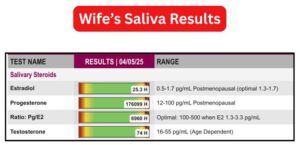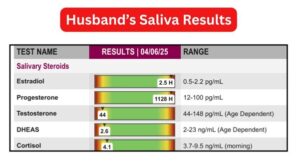Recently, I encountered two male patients, one in his 50s and the other in his 70s, both presenting with significantly elevated levels of progesterone and estradiol. These individuals are unrelated and reside in separate towns; however, the cause of their elevated hormone levels was identical. Noting a pattern from previous cases in my practice, I asked both men if their wives use creams for hormone replacement, and both responded affirmatively. Let me illustrate why this was such an important question by explaining both cases in detail.
The first man in his 70’s joined my practice with his wife who is also in her 70’s. His wife had been undergoing hormone replacement therapy under the care of another local physician for several years. She was prescribed a bi-estrogen cream and progesterone cream for daily application. I advised her to discontinue the use of the bi-estrogen cream due to its non-bioidentical nature. Instead, we prescribed a bioidentical estradiol cream at the same strength for use until further test results are obtained. The previous physician had monitored hormone levels solely through blood tests and did not recommend frequent testing. Therefore, our next step involved conducting both blood work and saliva hormone tests to establish her baseline levels. Additionally, we performed blood and saliva tests to assess the husband’s current hormone levels.
As previously mentioned, saliva testing is considered the most accurate method for measuring sex hormone levels. Although these hormones circulate in the bloodstream, their activity occurs within the cells. This can be illustrated by comparing a patient’s blood test results with her saliva test results. Her blood test indicates that estradiol, progesterone, and testosterone levels were all within the normal range for a post-menopausal woman. However, the saliva test reveals significantly elevated levels of both estradiol and progesterone. Specifically, her estradiol level is 1,488% higher than the 95th percentile for women her age, and her progesterone level is 176,099% higher than the 95th percentile for women her age.


Additionally, I advise all my patients who choose to use creams for HRT that these creams can be transferred to their spouse and other individuals they are physically close to. Unfortunately, the patient’s previous physician did not inform her about this risk, and thus she did not take measures to prevent her husband from contacting the creams. Consequently, the husband’s saliva test results indicate that he has also been exposed to elevated levels of estradiol and progesterone through his wife. Specifically, his estradiol level is 114% higher than the 95th percentile for men of his age, and his progesterone level is 1,128% higher than the 95th percentile for men of his age. This is why the first question I asked was “is your wife using a cream for hormone replacement?”

A gentleman in his 50s visited to review the results of his saliva hormone test, as he has been undergoing testosterone replacement therapy. His testosterone levels were optimal; however, we observed a significant increase in his progesterone level over the past year. Upon inquiring if his wife was using a hormone replacement cream, he responded that he was unsure. Since his wife is not our patient, I requested he contact her for clarification. It was confirmed that she had recently been prescribed a daily progesterone cream to be applied before bed. Unfortunately, her physician did not inform her of the potential transfer of the cream to her husband, which could impact his hormone levels.

Fortunately, these men chose to join my practice, which allowed us to identify a significant issue with their hormone levels that might otherwise have gone unnoticed. We can now address this problem and work towards balancing their hormones effectively. These cases underscore the critical importance of entrusting your hormone replacement therapy to a knowledgeable and experienced physician.
